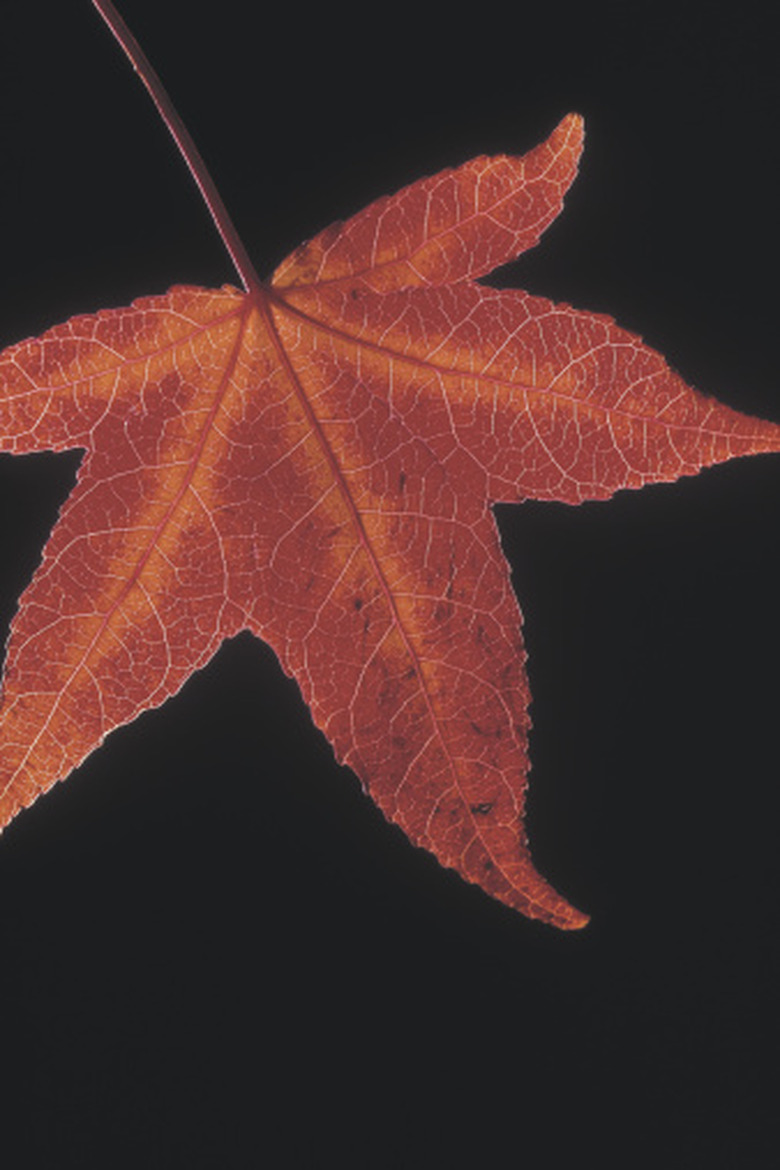Differences Between Maple & Sweet Gum
If you are looking for a large, long-lived yard tree, both maple and sweetgum are good choices. Both are hardwoods, much prized by furniture makers. Both grow to heights between 60 and 100 feet, providing summer shade, attractively ridged gray bark, autumn color and fruit-capsules that bring entertainment to children. Both are relatively low in vulnerability to disease. It is the differences between these two tree varieties, however, that will help you to identify them in nature and make a final choice for your yard.
Sweetgum
Sweetgum
The North American sweetgum tree, Liquidambar styraciflua, is a member of the witch-hazel, or Hamamelieaceae, family. Members of this small family also include a variety of sweetgum growing in eastern Mexico and Liquidambar orientalis, which is native to Central Asia. The sweetgum from which its name derives is a layer of resin under the bark, which gives the tree its distinctive but non-perfumy fragrance. Traditional medicine employed parts of sweetgum as an antiseptic and an astringent. Children have chewed the resinous sap like chewing gum. Southern nicknames for sweetgum include red gum and alligator wood. Sweetgum is second only to oak in production of wood for furniture, cabinetwork and veneers.
Maple
Maple
Between two websites about maple trees, more than 30 varieties are listed as growing in the U.S., from the very large black, or rock, maple, Acer nigrum, to the small and dwarf Japanese maple, Acer palmatum. Several varieties, including the black maple and the canyon maple, Acer grandidentatum, contain sweet sap that can be converted to sugar or syrup, in addition to the sap of the well-known Acer saccharum, or sugar maple. Maples as a whole are prized by the furniture industry; sugar maple trees provide the birdseye, curly and fiddleback woods valued for fine cabinetmaking.
Range
Range
The same sweetgum Liquidambar styrachiflua can be found throughout the eastern half of the U.S., growing from southern Connecticut and Illinois in the north down through the Deep South states as far west as Texas. Maple varieties are far more territorial. While maples thrive in most U.S. states, up into Canada and as far north as Alaska, eastern and western varieties do not overlap. Some maple varieties, such as Canyon maple, confine their range to a small area, Arizona, New Mexico and parts of southern Idaho. Chalk maple, Acer leucoderma, thrives from North Carolina south to Florida and west to Texas, overlapping with the Florida maple, Acer barbatum. In size and shape, varieties vary considerably. The same is true in the Northeast, where as many as a dozen varieties of maple overlap.
Leaves
Leaves
A single family member has a consistency in leaf shape that a group of relatives does not. Sweetgum leaves are palmate, or flat and hand-shaped, with five or sometimes seven pointed lobes with serrated edges. Maple leaves resemble sweetgum leaves and each other in their palmate shape. Lobes on many varieties are, however, smaller than the center of the leaf and range from very to only slightly pointy. Japanese maple, whose name includes a description of leaf shape, Acer palmatum, is known for leaves with anywhere from seven to 11 deeply cut and visibly toothed lobes in its leaves. Canyon maple leaves have sharply cut lobes, consistent with its name Acer grandidentatum. Leaves of the mountain maple, Acer spicatum, on the other hand, have shallow lobes, more discernible in leaf veins rather than leaf shape. Maple leaves turn a variety of colors in the fall, ranging from reds to yellows, oranges and browns.
Fruit/Seeds
Fruit/Seeds
The ultimate difference between sweetgum and maple trees is planted in the minds of children at first contact. Sweetgum seed delivery involves 1-to-1 1/4-inch-sized balls containing many individual fruits, ending in sharp-pronged points and each containing one or two long-winged seeds. These brown "gumballs" are sturdy, able to survive being stepped on. Maple samaras are more easily trod on, flat-winged pods each containing a single-seed fruit. The auto-rotation characteristic of samaras' fall has stimulated many children and occasional adults to explore its adaptation to aviation.
